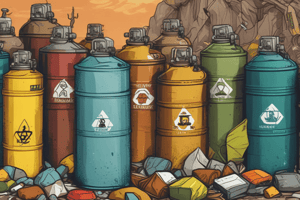Podcast
Questions and Answers
Which of the following is NOT a characteristic used to classify toxic and hazardous waste?
Which of the following is NOT a characteristic used to classify toxic and hazardous waste?
- Reactivity
- Density (correct)
- Corrosivity
- Infectivity
A laboratory has several containers of chemicals that are no longer needed. One is a highly reactive compound that violently reacts with water. According to the classification of hazardous waste, which category does this chemical primarily fall under?
A laboratory has several containers of chemicals that are no longer needed. One is a highly reactive compound that violently reacts with water. According to the classification of hazardous waste, which category does this chemical primarily fall under?
- Reactivity (correct)
- Ignitability
- Corrosivity
- Toxicity
Which treatment method involves using microorganisms to break down hazardous substances into less toxic forms?
Which treatment method involves using microorganisms to break down hazardous substances into less toxic forms?
- Biological Treatment (correct)
- Chemical Treatment
- Thermal Treatment
- Physical Treatment
A hospital needs to dispose of used bandages and hypodermic needles. Which classification of toxic and hazardous waste do these materials fall under?
A hospital needs to dispose of used bandages and hypodermic needles. Which classification of toxic and hazardous waste do these materials fall under?
A waste management facility is considering different methods for treating organic waste. Which of the following biological treatments would be most suitable?
A waste management facility is considering different methods for treating organic waste. Which of the following biological treatments would be most suitable?
Which of the following treatment methods is best suited for detoxifying and destroying organic wastes using high temperatures?
Which of the following treatment methods is best suited for detoxifying and destroying organic wastes using high temperatures?
Which of the following Republic Acts provides a comprehensive legal framework for the management of ecological solid waste in the Philippines?
Which of the following Republic Acts provides a comprehensive legal framework for the management of ecological solid waste in the Philippines?
What is the primary purpose of leachate collection systems in secure landfills?
What is the primary purpose of leachate collection systems in secure landfills?
Which government agency is authorized by the OSH Act to address workplace hazards related to toxic and hazardous waste?
Which government agency is authorized by the OSH Act to address workplace hazards related to toxic and hazardous waste?
A factory is looking to implement a waste treatment method for heavy metals. Which chemical treatment method is most appropriate?
A factory is looking to implement a waste treatment method for heavy metals. Which chemical treatment method is most appropriate?
Flashcards
Ignitability
Ignitability
Wastes that burn at low temperatures, creating an immediate fire hazard.
Corrosivity
Corrosivity
Strong acids or bases that can destroy solid material and living tissue on contact.
Reactivity
Reactivity
Chemically unstable substances that react violently with air or water, causing explosions or toxic vapors.
Toxicity
Toxicity
Signup and view all the flashcards
Pathogenicity
Pathogenicity
Signup and view all the flashcards
Physical Treatment
Physical Treatment
Signup and view all the flashcards
Chemical Treatment
Chemical Treatment
Signup and view all the flashcards
Biological Treatment
Biological Treatment
Signup and view all the flashcards
Thermal Treatment
Thermal Treatment
Signup and view all the flashcards
EPCRA
EPCRA
Signup and view all the flashcards
Study Notes
- Toxic and hazardous waste originates from various sources, posing risks to human and environmental health due to their chemical, biological, or radiological properties.
- Specialized treatment methods are needed to prevent pollution and long-term ecological damage.
Classification of Toxic and Hazardous Waste
- Ignitable wastes (flammable solvents) burn at low temperatures and create immediate fire hazards.
- Corrosive wastes (acids and bases) are strong acidic or alkaline substances that destroy solid material and living tissue upon contact through chemical reactions.
- Reactive wastes (explosive chemicals) are chemically unstable, reacting violently with air or water, potentially causing explosions or forming toxic vapors.
- Toxic wastes (heavy metals, pesticides) contain poisons, even in small amounts.
- Infectious wastes include used bandages and hypodermic needles from hospitals or biological research facilities.
- Pathogenic wastes have the capacity to harbor and transmit pathogens, particularly solid and healthcare waste, posing risks to public health and the environment.
- Hazardous waste treatment includes chemical, thermal, biological and physical methods.
- High-temperature incineration can detoxify and destroy organic wastes.
Methods of Treatment
- Physical Treatment separates hazardous components without altering their chemical nature.
- It includes Filtration and Sedimentation, often used in wastewater treatment to remove suspended particles
- It includes Solidification and Stabilization for encapsulating hazardous waste in materials like cement to prevent leaching.
- Chemical Treatment alters hazardous waste properties to make them less harmful.
- Neutralization mixes acids and bases to form neutral compounds.
- Oxidation and Reduction treats heavy metals and organic pollutants
Biological Treatment
- Microorganisms break down hazardous substances into less toxic forms.
- Bioremediation uses bacteria and fungi to degrade contaminants
- Composting decomposes organic hazardous waste into stable matter.
Thermal Treatment
- This involves using high temperatures to destroy hazardous substances.
- Incineration burns hazardous waste, reducing volume but may produce toxic emissions
- Plasma Arc Technology uses ionized gas at high temperatures to break down complex chemicals.
- Secure Landfilling is used for waste that cannot be treated, using engineered landfills that must have
- Leachate collection systems to prevent groundwater contamination.
- Gas recovery systems to capture harmful emissions
Laws Governing Toxic and Hazardous Waste Treatment
- Republic Act 6969, also known as the Toxic Substances and Hazardous and Nuclear Wastes Control Act of 1990, regulates and prohibits importing, manufacturing, processing, sale, distribution, use, and disposal of hazardous chemicals; it also encourages toxic chemical research.
- Republic Act 9003, also known as the Ecological Solid Waste Management Act of 2000, establishes a systematic ecological solid waste management program. This promotes resource conservation and recovery through environmentally sound methods like composting, recycling, and green charcoal processes, aimed at volume reduction and waste avoidance.
- Republic Act 9275, also known as the Philippine Clean Water Act of 2004 is an "Economic Growth Policy for Fresh, Blackfish, and Marine Waters" signed on March 22, 2004 by President Gloria Macapagal-Arroyo and put into effect on May 6, 2004.
- Republic Act 8749, also known as the Philippine Clean Air Act of 1999 or the "Air Pollution Control Law", sets regulations for air quality protection, strict emission standards, and it aims to reduce pollutants and promote sustainable development.
- Presidential Decree 1586, also known as the Environmental Impact Statement (EIS) System of 1978, introduced the Environmental Impact Statement (EIS) System to balance socio-economic development and environmental protection. It mandates all projects with significant environmental impacts to prepare an EIS, empowers the Minister of Human Settlements to designate lead agencies for EIS preparation, requires an Environmental Compliance Certificate for environmentally critical projects, and authorizes the President to declare certain projects as environmentally critical.
Federal Laws pertaining to waste
- RCRA sets standards for hazardous waste management.
- TSCA allows EPA regulation of hazardous chemicals.
- OSH Act authorizes OSHA to address workplace hazards.
- Clean Water Act regulates pollutants discharge into national waters.
- EPCRA requires chemical, facility owners to submit reports and present public information.
Studying That Suits You
Use AI to generate personalized quizzes and flashcards to suit your learning preferences.




